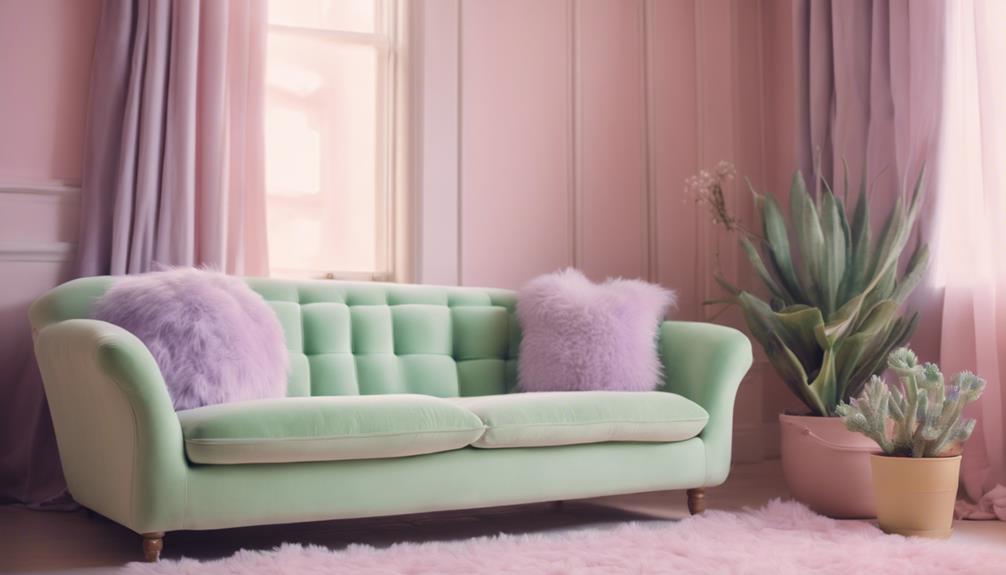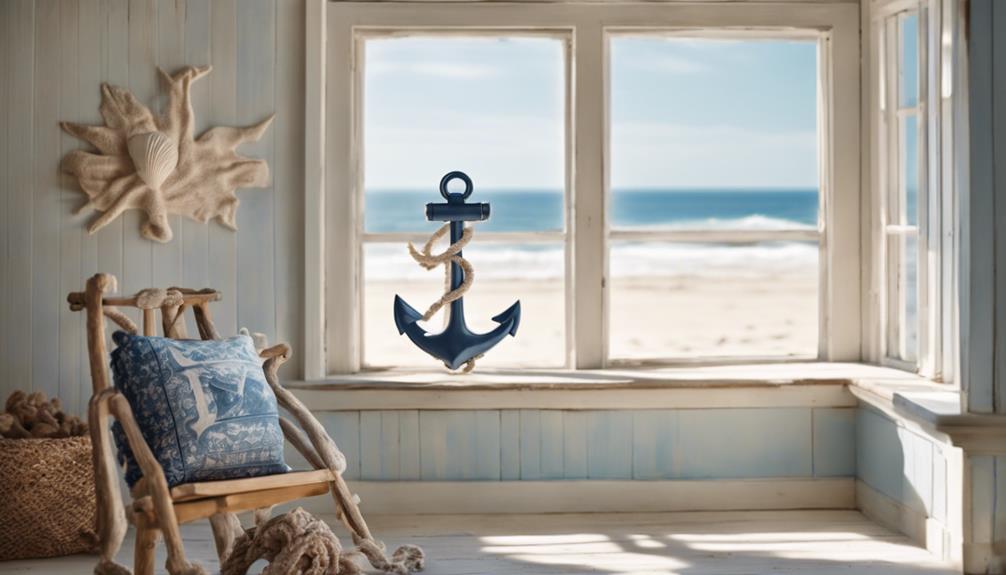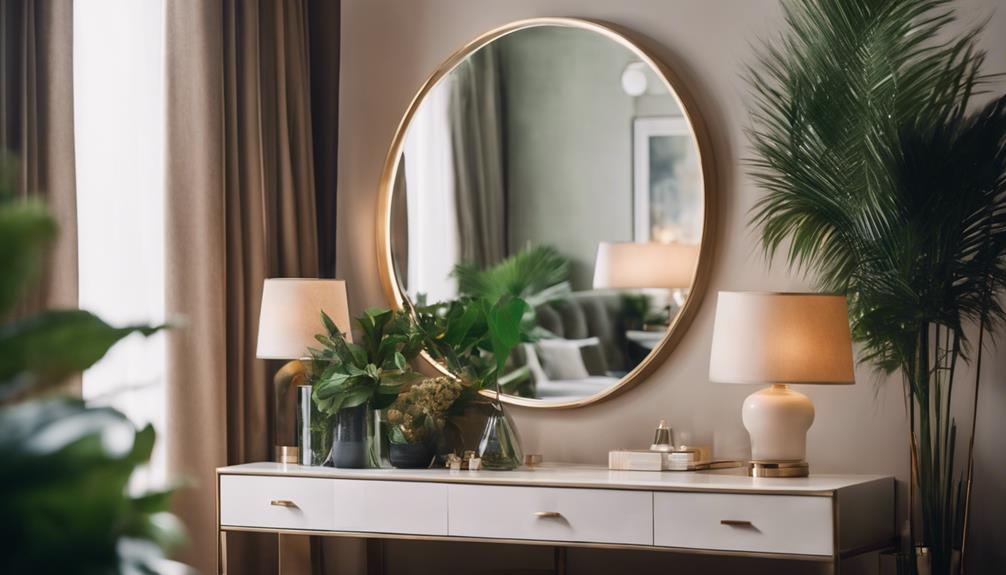Pastel room decor transforms your space into a soft, inviting haven that captivates everyone. Start with a calming color scheme, using hues like blush pink, mint green, and baby blue. Incorporate textures with chunky knit blankets and bubble candles for added warmth. Choose pastel furniture, like accent chairs and coffee tables, to create functional yet aesthetic focal points. Complement your design with soft lighting, such as pastel pendant lights and fairy lights, to enhance the ambiance. By thoughtfully blending these elements, you'll create a stunning space that impresses all who enter. Explore more tips to elevate your decor style!
Key Elements
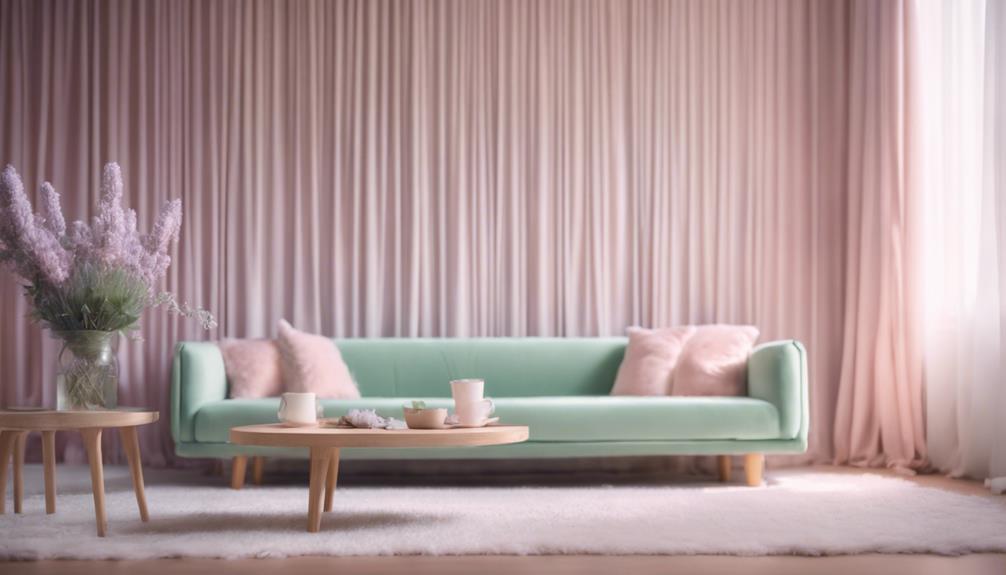
When you're crafting your pastel room decor, focus on three key elements: color scheme, materials, and textures.
Choosing the right colors and combining various materials can create a cohesive and inviting atmosphere.
You'll want to guarantee that your textures add depth and interest to the overall design.
Color Scheme
A pastel color scheme transforms your space with soft hues like blush pink, mint green, and baby blue, creating a calming and inviting atmosphere. When you choose different colors, you can add depth and dimension to your pastel room while maintaining a cohesive look. This allows you to playfully combine shades without overwhelming the senses.
Incorporate a balanced mix of pastel colors to make your room decor more dynamic and visually interesting. Rather than relying on a single shade, use combinations like lavender and pale yellow to keep the aesthetic fresh and lively. Accent pieces in pastel tones, such as floral bedding or bubble candles, enhance the overall look and serve as focal points, drawing the eye and creating a welcoming vibe.
Don't forget to add functional accessories like pastel storage crates and wavy mirrors. They not only contribute to your color scheme but also help maintain an organized and stylish environment. By thoughtfully selecting your pastel colors and accessories, you'll create a beautiful space that impresses everyone who enters.
Materials
Incorporating key materials like bubble candles, wavy mirrors, and chunky knit blankets elevates your pastel room decor by blending functionality with style.
Bubble candles add a cute and calming touch, especially if you choose scented options that create a soothing atmosphere. Wavy mirrors serve as trendy focal points, enhancing the visual interest in your room while seamlessly fitting into the pastel aesthetic.
Don't overlook the importance of storage; pastel storage crates can keep your space organized and contribute to a cohesive color scheme. Layering in chunky knit blankets not only boosts comfort but also adds a cozy, inviting feel.
To further enhance your decor, consider stringing up fairy lights around your room. They add a magical glow, making your space feel more enchanting, especially when combined with soft pastel hues.
You can also drape fake vines along walls or around furniture to introduce a touch of nature without overwhelming the pastel palette. By thoughtfully selecting these materials, you'll create a serene and aesthetic environment that impresses everyone who steps into your pastel sanctuary.
Textures
Textures play an essential role in enhancing the cozy and inviting atmosphere of your pastel room decor. By thoughtfully combining various textures, you can create a visually appealing space that feels warm and welcoming. For instance, incorporating a chunky knit blanket instantly adds warmth and a tactile element, perfectly complementing your soft color scheme.
Floral bedding is another key component; it introduces gentle patterns and textures that harmonize beautifully with pastel hues.
Don't forget about the impact of wavy mirrors. They not only reflect light, making the room feel larger, but also add a unique texture that catches the eye and adds dimension.
Bubble candles bring both tactile and visual interest to your space. Their sculptural shapes serve as charming focal points while fitting seamlessly into a pastel palette.
Additionally, pastel storage crates can be both practical and stylish, offering varied textures that keep your room organized without sacrificing aesthetics.
Essential Fixtures and Furniture
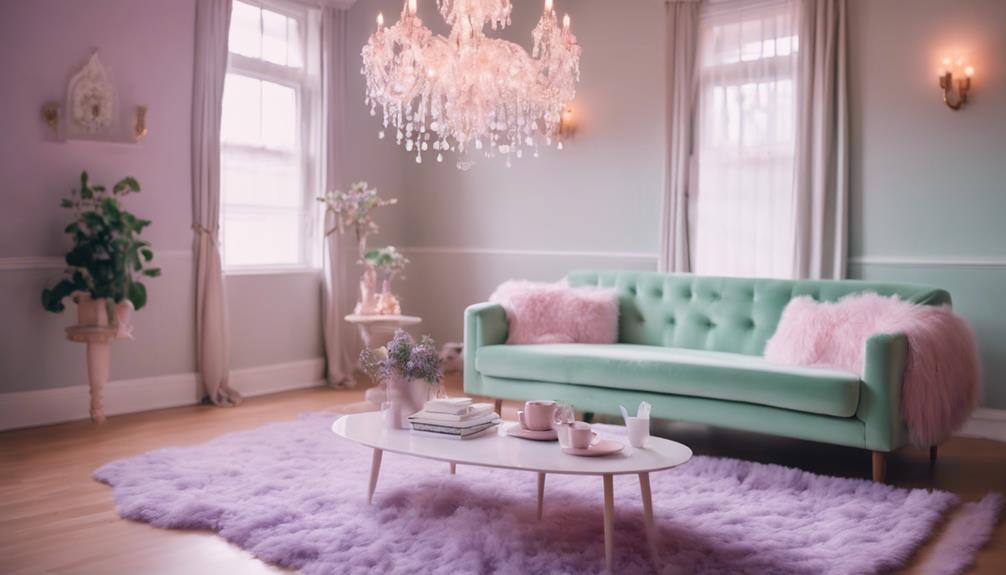
When you're choosing essential fixtures and furniture for your pastel room, consider a pastel-hued accent chair to add comfort and style.
A pastel coffee table can serve as a functional centerpiece, while a pastel bookshelf with curved shelves offers a unique way to display your favorite books and decor.
These pieces not only enhance the room's aesthetic but also help create a cohesive and inviting space.
Pastel-Hued Accent Chair
A pastel-hued accent chair can instantly brighten your space, serving as a stylish focal point that invites comfort and relaxation. Choosing a chair in muted tones like blush pink or mint green not only adds a pop of color but also enhances the overall soothing aesthetic you're aiming for.
When you incorporate a pastel accent chair into your decor, think about how it complements other elements, such as floral bedding or decorative bubble candles. This creates a cohesive look that feels inviting and harmonious. Opt for a chair with unique design elements, like curved lines or textured fabric, to elevate your room's overall style.
To make your seating area more functional, consider pairing your pastel chair with a coordinating side table or some throw pillows in similar hues. This combination not only enhances visual appeal but also creates a comfortable and stylish nook perfect for relaxation or reading.
With the right pastel accent chair, you'll successfully transform your space into a soft and aesthetic retreat that impresses everyone who steps inside.
Pastel Coffee Table
Incorporating a pastel coffee table into your decor not only enhances the room's aesthetic but also provides a versatile surface for everyday use and decorative displays. This piece can serve as a striking focal point, drawing the eye and tying together the pastel color scheme in your space.
If you're looking for a budget-friendly option, consider a DIY tile side table in pastel hues. It adds a unique touch and showcases your creativity. Additionally, a whimsical flower side table can perfectly complement your pastel theme while offering extra surface area for decor.
To keep your space organized and stylish, incorporate pastel storage crates under or around your coffee table. These can discreetly hold items while maintaining the soft color palette you've chosen.
Accessorizing your pastel coffee table is key to creating an inviting atmosphere. Try adding colorful wavy vases or bubble candles, which not only enhance the table's appeal but also contribute to a cohesive look throughout the room.
Pastel Bookshelf With Curved Shelves
Curved shelves on a pastel bookshelf add a whimsical touch to your decor while perfectly complementing the soft color palette of your space. These shelves create a flowing visual effect, making your room feel inviting and unique.
To enhance functionality, consider incorporating pastel storage crates within the bookshelf design. They not only organize books and decor items but also maintain a cohesive look that ties everything together.
Accessorize your curved shelves with colorful wavy vases or bendy candles. These decorative pieces add character and charm, turning your bookshelf into a stunning focal point. If you choose a pastel bookshelf with A-frame tilted shelves, you'll enjoy easy visibility of your favorite books and decor items, effectively adding depth to your design.
Don't forget to curate the surrounding area! Hanging Matisse posters alongside your personal photo prints creates a gallery-like atmosphere that elevates the overall aesthetic.
With thoughtful arrangement and the right accessories, your pastel bookshelf won't only be functional but also a beautiful centerpiece that impresses everyone who enters your space.
Lighting Ideas
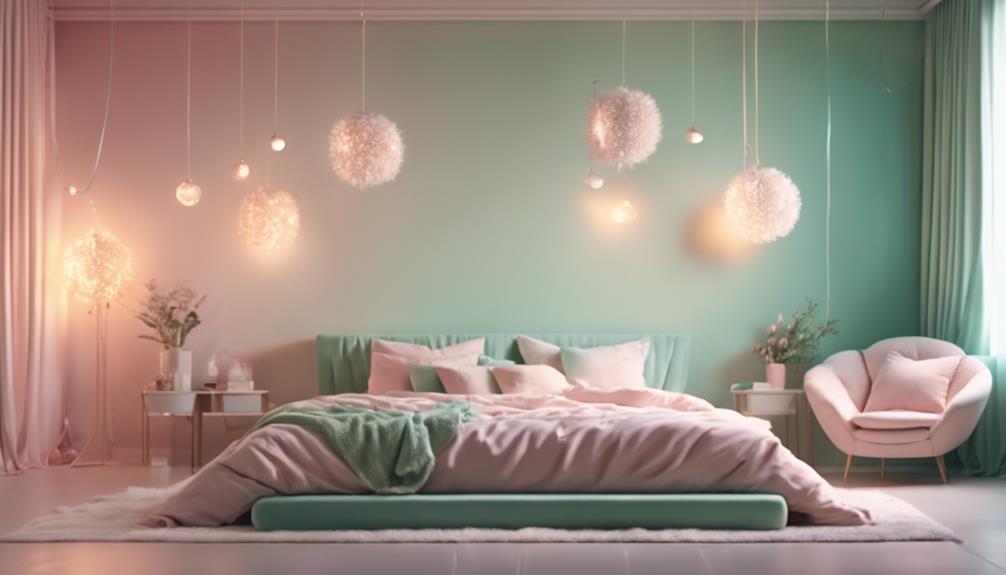
When it comes to lighting your pastel room, you'll want to focus on creating a warm and inviting ambiance.
Consider soft pastel pendant lights and wall-mounted sconces that complement your decor while providing functional illumination.
Don't forget to add dimmer switches and string lights for that perfect cozy glow.
Soft Pastel Pendant Lights
Soft pastel pendant lights, available in shades like blush pink, mint green, and baby blue, instantly transform any space into a calming and aesthetic haven. These lights not only provide functional illumination but also serve as eye-catching statement pieces that complement your pastel-themed decor. With unique designs ranging from geometric shapes to organic forms, they effortlessly add a modern touch while maintaining a soft aesthetic.
When you hang these pendant lights at different heights, you create visual interest and dimension in your room. This layered look can make your space feel cozier and more inviting. You'll find that incorporating pastel pendant lights ties together other pastel elements, enhancing the overall theme of your decor.
Moreover, while discussing lighting, think about pairing these fixtures with dimmable bulbs. This allows you to adjust the brightness to suit any mood, whether you're hosting friends or enjoying a quiet evening at home.
Dimmer Switches for Soft Glow
Installing dimmer switches transforms your lighting experience, allowing you to easily create a soothing ambiance that perfectly complements your pastel decor. With a simple adjustment, you can switch from bright, functional lighting for tasks to a soft, inviting glow ideal for relaxation or social gatherings.
One of the best features of dimmer switches is their compatibility with various light types, including LED, incandescent, and halogen bulbs. This flexibility means you can choose the right lighting solution that fits your style and needs. A softer light setting enhances the serene pastel aesthetic, making your space feel cozy and welcoming.
Additionally, many modern dimmer switches come equipped with smart technology, enabling you to control your lighting remotely or set schedules for automatic adjustments. This can help you effortlessly shift from day to night, ensuring your room maintains the perfect vibe at all times.
Wall-Mounted Pastel Sconces
Wall-mounted pastel sconces add a touch of elegance to your space while providing the soft lighting that complements your pastel decor beautifully. These sconces not only serve a functional purpose but also enhance the aesthetic appeal of your room. Available in various pastel shades like mint green, blush pink, and lavender, they help maintain a cohesive color palette throughout your space.
Many pastel sconces come with unique designs, featuring geometric shapes or organic forms, acting as eye-catching focal points on your walls. This creativity can transform an ordinary wall into a stunning visual feature. Plus, installing wall-mounted sconces saves valuable floor space, making them perfect for smaller rooms or areas where maximizing space is crucial.
To create a harmonious and inviting atmosphere, consider pairing your sconces with other pastel-themed decor items such as bubble candles or floral bedding. This combination not only elevates your room's aesthetic but also guarantees a cohesive look.
Pastel String Lights for Ambiance
Pastel string lights instantly create a warm and inviting atmosphere, perfect for enhancing your room's ambiance. Available in soft pink, mint green, and lavender, these lights can beautifully complement your pastel decor. You can easily drape them over furniture, along walls, or around windows, casting a magical glow throughout the space.
One of the best features of pastel string lights is their energy-efficient LED bulbs. They not only save you money on electricity but also have a longer lifespan compared to traditional incandescent lights. This means you can enjoy their soft illumination without constantly worrying about replacements.
Incorporating these lights into your decor elevates the aesthetic of your room, making it ideal for relaxation or entertaining guests. If you want even more control over the ambiance, look for string lights with dimmable settings or remote controls. This way, you can customize the brightness to fit any mood or occasion.
Whether you're hosting a cozy gathering or winding down after a long day, pastel string lights are an essential element in creating that perfect atmosphere in your pastel oasis.
Decorative Elements
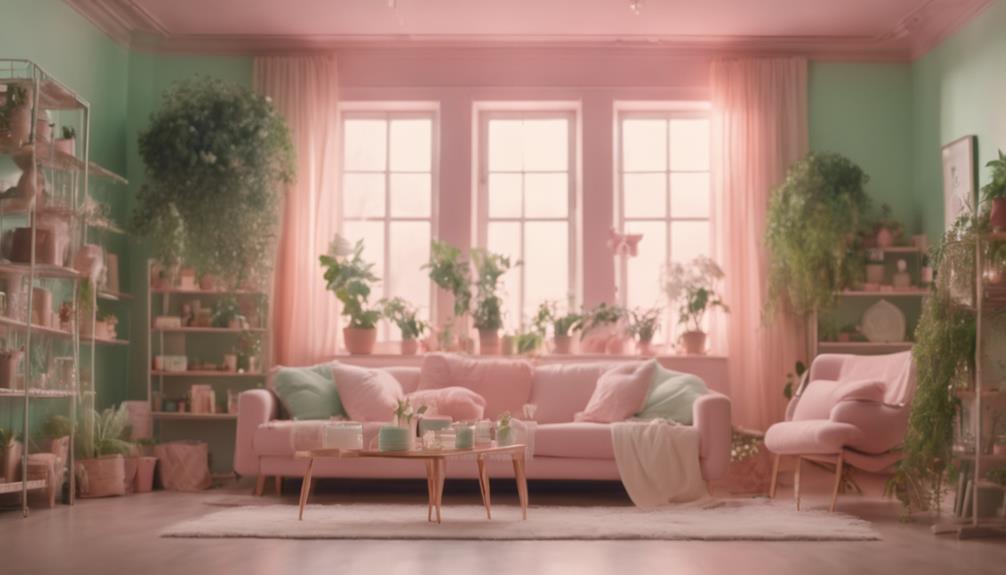
When you're looking to enhance your pastel room, consider incorporating decorative elements like pastel ceramic vases, framed wall art, and throw pillows.
These items not only add color but also bring depth and personality to your space.
Let's explore how each of these elements can transform your decor.
Pastel Ceramic Vases
Ceramic vases in soft, pastel hues offer a stylish way to enhance your decor, providing both versatility and charm for any room. These vases come in various shapes and sizes, allowing you to mix and match them to complement different styles in your pastel-themed space. Their smooth, glossy finishes accentuate the soft colors, making them eye-catching elements that can either showcase vibrant floral arrangements or stand alone as art pieces.
Many pastel ceramic vases are hand-crafted or feature unique textures, adding a personalized touch that elevates your overall aesthetic. Use them to hold seasonal flowers like tulips or peonies, which not only bring a touch of nature indoors but also harmonize beautifully with the soft color palette typical of pastel decor.
Incorporating pastel ceramic vases into your decor helps create an inviting atmosphere. Their calming presence evokes tranquility, making your space feel cozy and stylish. Whether you place them on a mantel, a coffee table, or a shelf, these vases are sure to impress anyone who enters your home, all while enhancing the serene vibe you're aiming for.
Pastel Framed Wall Art
Incorporating framed wall art in soft hues can instantly elevate your space, introducing calming visuals that harmonize perfectly with a pastel-themed decor.
Pastel framed wall art is essential for transforming your room, as it provides both color and character. Consider adding Matisse posters; their unique shapes and plant designs bring a modern touch that complements pastel aesthetics beautifully.
You can also explore collage prints from online platforms, allowing you to personalize your artwork while maintaining that soft color scheme. Think about mixing different styles and sizes for an engaging gallery wall that reflects your taste and creativity.
Don't overlook functional pieces like digital clocks with pastel frames. They serve a practical purpose while adding a stylish focal point to your wall decor. Tapestries in soft pastel hues can enhance your room further, offering a stunning backdrop that ties everything together.
When you choose the right pastel framed wall art, you create a serene atmosphere that impresses everyone. So, gather your favorite pieces, arrange them thoughtfully, and watch your space transform into a soft and aesthetic haven.
Pastel Throw Pillows
Pastel throw pillows instantly brighten your space, adding a touch of softness and comfort that enhances your overall decor. Available in shades like soft pinks, mint greens, and baby blues, these pillows perfectly complement the pastel aesthetic you're aiming for. You can choose from various textures and patterns, such as ruffles or geometric designs, which add depth and visual interest to your room.
Incorporating pastel throw pillows into your seating area not only boosts comfort but also serves as a stylish way to introduce color without overwhelming the space. Opt for pillows with removable covers for easy cleaning and the flexibility to switch up your decor seasonally or whenever you feel like a change.
Layering pillows of varying sizes and shapes can create a cozy, inviting atmosphere, making your space feel more curated and thoughtful.
Whether you place them on your sofa, bed, or favorite reading chair, pastel throw pillows are a simple yet effective way to elevate your room's overall aesthetic. Embrace their charm and let them transform your space into a soft, inviting haven.
Flooring
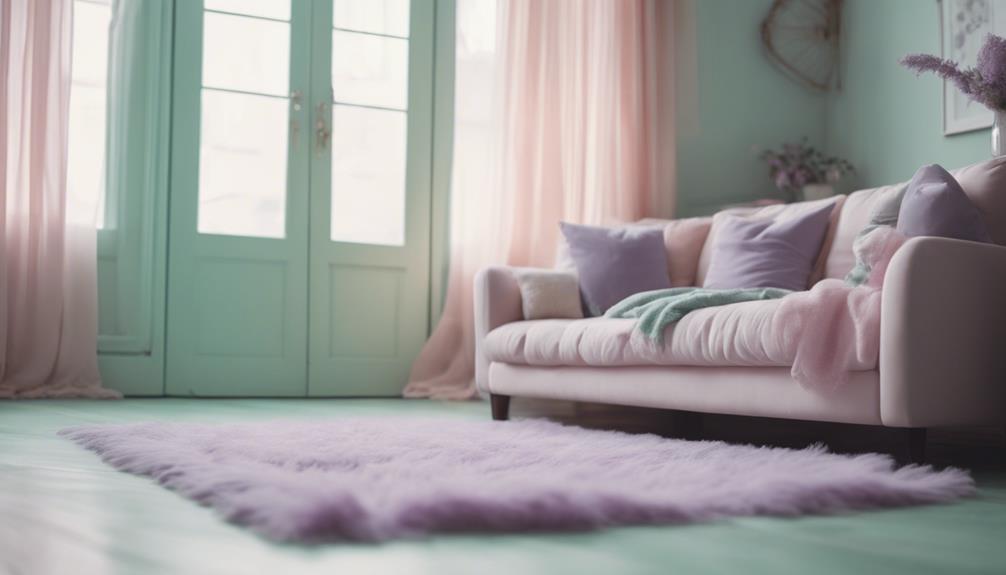
When you're choosing flooring for your pastel room, consider light pastel laminate for a stylish and durable base.
Soft pastel area rugs can introduce warmth and comfort,
while pastel cork flooring offers a unique, eco-friendly option.
Each choice can enhance your space's overall vibe and feel.
Light Pastel Laminate Flooring
Light pastel laminate flooring creates a soft, airy foundation that beautifully enhances your room's overall pastel aesthetic while reflecting natural light to make the space feel larger and more inviting. Available in shades like pale pinks, soft blues, and mint greens, this flooring offers versatile design options that can complement any decor style.
You'll appreciate the durability and easy maintenance of light pastel laminate flooring, making it perfect for high-traffic areas. It maintains a cozy, stylish look without the hassle of constant upkeep. Many options feature a textured finish that mimics natural wood, adding warmth and character while staying true to the pastel theme.
The installation process is generally straightforward with a click-lock system, allowing for quick and hassle-free setup—ideal if you're a DIY enthusiast. You won't have to worry about complications, so you can focus on creating your dreamy pastel space.
Choosing light pastel laminate flooring not only enhances your room's aesthetic but also provides a functional base that withstands daily life. It's a smart choice for anyone looking to elevate their home decor effortlessly.
Soft Pastel Area Rugs
Soft pastel area rugs can instantly transform your room, adding color and warmth while enhancing the cozy atmosphere of your space. With shades like mint green, blush pink, and lavender, these rugs fit seamlessly into various pastel-themed aesthetics, allowing you to curate a soft and inviting environment.
Not only do these rugs add a splash of color, but they also create a comfortable surface to walk on, making your space feel even more welcoming. Most pastel rugs are crafted from materials such as cotton or microfiber, ensuring they're soft underfoot and easy to clean—perfect for everyday use.
A well-placed pastel area rug can effectively define different spaces in your room, like a reading nook or a bedroom area, creating a visually appealing focal point. When choosing your rug, think about the size and shape that best suits your layout. This consideration will enhance the balance and harmony of your decor, making the entire room feel cohesive.
Pastel Cork Flooring Option
Incorporating pastel cork flooring into your space not only complements your soft pastel area rugs but also enhances the overall aesthetic with its eco-friendly and stylish design. This flooring option is made from renewable materials, making it a sustainable choice for your home. You'll find pastel cork flooring in various shades, allowing you to create a cohesive look that ties your decor together beautifully.
One of the standout features of cork flooring is its natural resistance to mold, mildew, and pests, which means you can enjoy a cleaner and healthier environment with minimal maintenance. The cushioned surface provides comfort underfoot, making it perfect for areas where you might stand for long periods, such as kitchens or playrooms.
Additionally, pastel cork flooring is durable and effective at sound absorption, reducing noise levels in your space. This practicality enhances the ambiance of your pastel-themed room while ensuring it remains a tranquil haven.
Conclusion
By incorporating these pastel decor ideas, you can effortlessly transform your space into a soft, aesthetic haven that leaves everyone in awe.
Focus on key elements like essential fixtures, lighting, and decorative touches to create a cohesive look.
Don't forget about the flooring—it plays an essential role in setting the tone.
With a little creativity and the right choices, you'll craft a dreamy pastel room that reflects your personality and invites warmth into your home.
